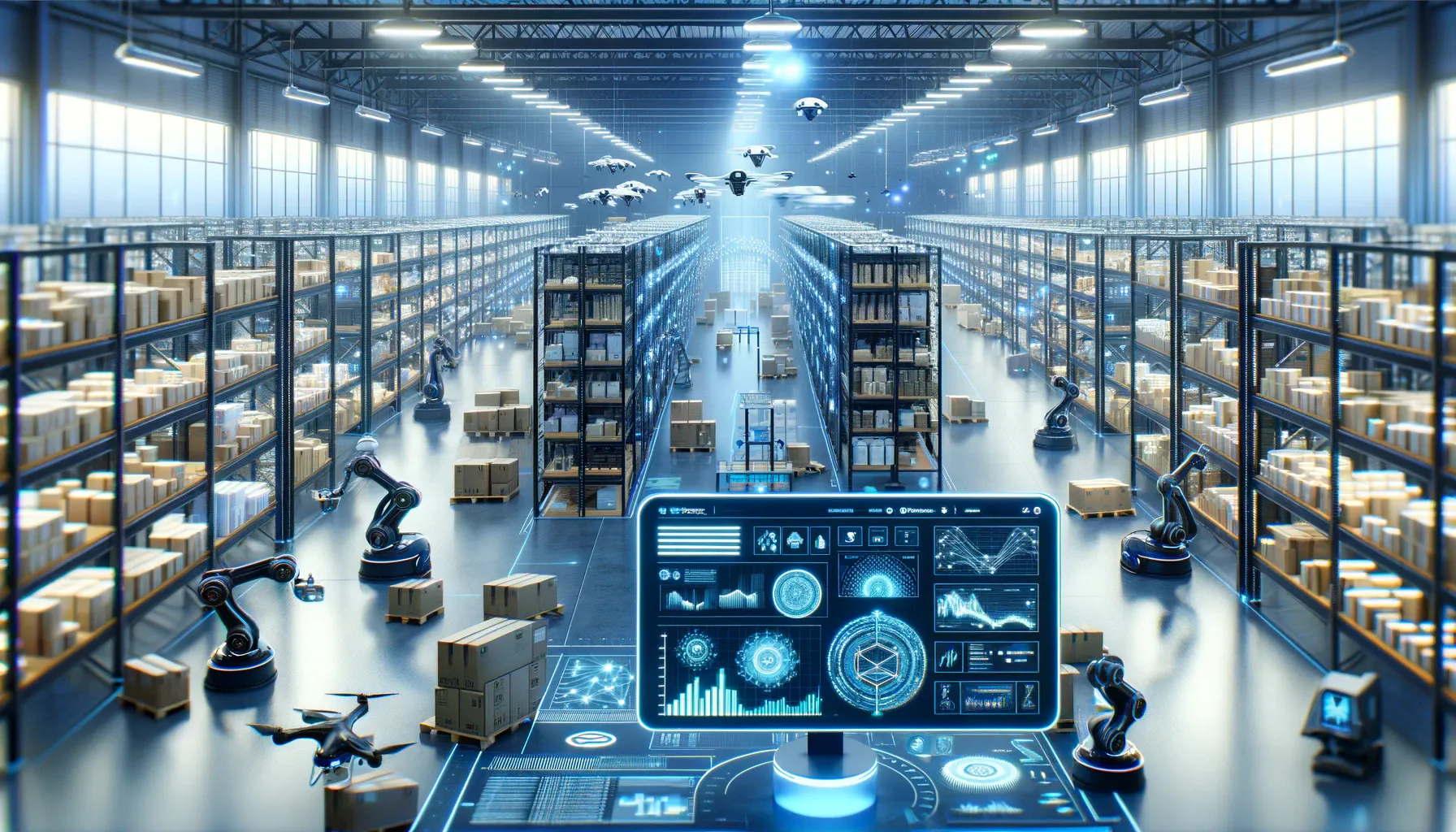Table of Contents
In the dynamic landscape of e-commerce, maintaining an optimal inventory balance is a constant challenge. The repercussions of stockouts are significant, leading to lost sales, dissatisfied customers, and potential brand erosion. This article explores how AI-driven inventory solutions are transforming the e-commerce sector, offering real-time examples of their impact and addressing the challenges faced by online retailers.
1. Understanding the E-commerce Inventory Conundrum

E-commerce inventory management involves a delicate balance between having enough stock to meet demand without overstocking and incurring unnecessary costs. Traditional approaches often fall short in adapting to the rapidly changing consumer behavior and market trends. This is where AI-driven inventory solutions come into play.
2. The Rise of AI-Driven Inventory Solutions
Predictive Analytics for Demand Forecasting
One of the primary challenges in e-commerce is accurately predicting consumer demand. AI-driven inventory systems leverage advanced predictive analytics to analyze historical data, market trends, and external factors such as weather patterns or social events.
Data Analysis and Historical Trends:
- Explanation: AI-driven inventory systems utilize predictive analytics to analyze historical sales data. The system identifies trends and seasonality in product demand by examining past purchasing patterns.
- Instance: Amazon’s recommendation system analyzes users’ past purchases and browsing history to suggest products they are likely to be interested in, contributing to accurate demand forecasting.
Market Trends and External Factors:
- Explanation: AI-driven inventory systems predictive analytics extends beyond internal data, incorporating external factors such as market trends, economic conditions, and social events. This holistic approach enhances the accuracy of demand forecasts.
- Instance: Alibaba incorporates data from various sources, including social media trends and economic indicators, to predict consumer demand during events like Singles’ Day in China, ensuring sufficient inventory for the surge in online shopping.
Dynamic Adjustments in Real-Time:
- Explanation: AI-driven inventory systems predictive analytics enables real-time adjustments to demand forecasts, allowing for agile inventory management.
- Instance: Retailers like Zara use AI to adjust their inventory in response to changing fashion trends. By continuously analyzing sales data and social media trends, Zara can quickly adapt its inventory to meet evolving consumer preferences.
Dynamic Pricing Strategies
Real-Time Market Conditions:
- Explanation: AI-driven inventory systems use dynamic pricing involves adjusting product prices in real-time based on various factors affecting market conditions.
- Instance: E-commerce platforms monitor supply and demand fluctuations, updating prices for products like electronics or fashion items during peak shopping seasons.
Demand-Based Pricing:
- Explanation: AI algorithms analyze demand patterns to optimize pricing, ensuring competitive rates during high-demand periods.
- Instance During Black Friday sales, e-commerce retailers may dynamically adjust prices for popular items to reflect increased demand, encouraging sales while maximizing revenue.
Competitor Pricing Analysis:
- Explanation: AI systems track competitors’ pricing strategies and adjust prices to maintain competitiveness in the market.
- Instance: An online electronics store may lower its prices slightly if a competitor offers a similar product at a lower cost, ensuring it remains an attractive option for consumers.
Smart Shelves and Inventory Automation
Smart Shelves Overview:
- Definition: Smart shelves are equipped with sensors and RFID technology, allowing them to monitor inventory levels in real-time.
- Purpose: To automate inventory management processes and reduce the likelihood of stockouts.
Real-Time Monitoring:
- How it Works: Sensors on smart shelves continuously track the quantity of products on the shelf.
- Instance: In a physical retail store, sensors on smart shelves can detect when a product is running low and trigger an alert for restocking.
AI Algorithms for Automated Reordering:
Role of AI: AI algorithms analyze real-time inventory data to predict when and how much to reorder.
Instance: Amazon’s physical stores, like Amazon Go, leverage AI to automatically reorder products based on customer purchases, ensuring shelves are consistently stocked.
3. Real-Time Instances of AI-Driven Inventory Solutions
Zara: Fast Fashion Powered by AI: Fast-fashion retailer Zara has embraced AI to revolutionize its inventory management. By analyzing sales data, social media trends, and customer preferences, Zara uses AI algorithms to predict the next big fashion trends. This predictive capability allows the company to manufacture and stock its stores with the latest styles quickly. The result is a minimized risk of overstocking and a maximized ability to meet customer demand for trendy items.
Walmart: Optimizing Inventory with Machine Learning: Walmart, a retail giant, utilizes machine learning algorithms to optimize its inventory and distribution network. By forecasting demand and analyzing historical sales data, Walmart ensures that its shelves are stocked with the right products at the right time.
This not only prevents stockouts but also minimizes excess inventory, leading to significant cost savings. Walmart’s success with AI-driven inventory management serves as a testament to the transformative impact of these technologies on large-scale retail operations.
Etsy: Personalized Inventory Recommendations: E-commerce platform Etsy leverages AI to provide personalized inventory recommendations to its users. By analyzing individual browsing and purchasing patterns, Etsy’s recommendation system suggests products that align with users’ preferences.
This not only enhances the shopping experience for users but also optimizes inventory turnover for sellers. Etsy’s use of AI showcases the potential for personalization in inventory management, catering to the diverse needs and tastes of online shoppers.
4. Challenges in Implementing AI-Driven Inventory Solutions
While the benefits of AI-driven inventory management are evident, challenges persist in the implementation of these advanced systems.

Data Security and Privacy Concerns:
Privacy Risks: The accumulation of sensitive information poses risks if not adequately protected, leading to potential privacy breaches and unauthorized access.
Instance: In 2013, Target suffered a data breach where hackers gained access to customer data, including credit card information.
User Consent and Transparency: Users must be informed about how their data is used, and consent must be obtained for data processing activities.
Instance: GDPR (General Data Protection Regulation) in the European Union mandates businesses to obtain explicit user consent and provide transparency in data processing.
Security Measures: E-commerce businesses need robust cybersecurity measures, encryption, and secure storage to protect user data from unauthorized access.
Instance: PayPal employs encryption and multi-factor authentication to secure users’ financial information during transactions.
Integration with Existing Systems:
Data Compatibility:
- Challenge: Different systems may use varied data formats and structures, making it challenging to seamlessly integrate AI-driven inventory solutions.
- Instance: Imagine an e-commerce platform using a legacy system with data stored in a format incompatible with modern AI algorithms. Integrating AI requires converting and standardizing data to ensure compatibility.
Communication Protocols:
- Challenge: Ensuring smooth communication between AI-driven systems and existing platforms requires compatible communication protocols.
- Instance: In a real-world scenario, an e-commerce company may use an ERP system for inventory management. Integrating an AI-driven system involves establishing communication protocols that allow the two systems to exchange data in real-time.
Scalability:
- Challenge: As businesses grow, the scalability of integrated systems becomes crucial. The integration must be designed to handle increased data volumes and user interactions.
- Instance: Consider a fast-growing e-commerce startup that initially integrates AI for inventory management. As the business expands, the integrated system should seamlessly scale to accommodate the increased demand and complexity.
5. The Future of AI-Driven Inventory in E-commerce
As AI technology continues to advance, the future holds exciting possibilities for e-commerce inventory management.
Augmented Reality and Virtual Shopping Experiences:
Virtual Try-On for Apparel:
- Explanation: AI and AR technologies can enable virtual try-on experiences, allowing users to see how clothing items look on them without physically trying them on.
- Instance: The “AR Try-On” feature on the Warby Parker app lets users virtually try on different eyeglasses by superimposing the frames on their faces using AR technology. This helps customers make more informed purchasing decisions.
Furniture Visualization in Real Spaces:
- Explanation: AI-powered AR can be used to visualize furniture and home decor items in the user’s actual living space through their smartphone or tablet camera.
- Instance: The IKEA Place app uses AR to allow users to place virtual furniture in their homes. This helps customers visualize how items will fit into their space before making a purchase, reducing the likelihood of returns.
Makeup and Beauty Try-Ons:
- Explanation: AI and AR can simulate makeup and beauty product try-ons, allowing users to see how different products will look on their faces in real-time.
- Instance: The L’Oreal “Virtual Try-On” feature lets users try on different makeup products using their smartphone cameras. This enhances the online shopping experience for beauty products.
Blockchain for Transparent Supply Chains
Decentralized and Immutable Ledger:
- Explanation: Blockchain technology operates on a decentralized and immutable ledger. This means that the information recorded on the blockchain is distributed across a network of nodes, making it resistant to tampering or alteration.
- Instance: In the supply chain, each transaction, from the creation of a product to its delivery, is recorded on the blockchain. The immutability ensures that once a transaction is added to the blockchain, it cannot be changed. This feature is crucial for maintaining the integrity of the supply chain data.
Improved Traceability and Accountability:
- Explanation: The transparent and traceable nature of blockchain enables a clear and unbroken chain of custody for products. This fosters accountability as each participant in the supply chain can be identified, and their actions are recorded.
- Instance: De Beers, a diamond company, utilizes blockchain to track the origin and journey of diamonds from mines to consumers. This ensures that diamonds are ethically sourced and helps combat the trade in conflict diamonds, providing transparency that resonates with modern consumers seeking ethical options like Lab Grown Diamond rings.
Reduced Counterfeiting Risk:
- Explanation: Blockchain’s transparency helps in verifying the authenticity of products. Counterfeiting is mitigated as consumers and businesses can trace the entire history of a product, ensuring that it has not been tampered with or replaced.
- Instance: Everledger, a startup, uses blockchain to track the provenance of luxury goods, including diamonds and fine wines. This deters counterfeiting by providing a secure and unalterable record of the product’s journey.
Conclusion

The integration of AI-driven inventory solutions in e-commerce is transforming how businesses manage their stock, predict demand, and engage with customers. Real-time instances from industry leaders demonstrate the tangible impact of these technologies on efficiency, customer satisfaction, and overall business success. However, as we navigate this transformative era, addressing challenges such as data privacy and algorithmic bias is paramount to ensuring the responsible and ethical use of AI in e-commerce inventory management.
The future promises even more innovation, with augmented reality, blockchain, and other technologies poised to further enhance the e-commerce experience. As businesses continue to adapt, it’s clear that AI-driven inventory is not just a solution to stockouts but a catalyst for redefining the future of e-commerce.





